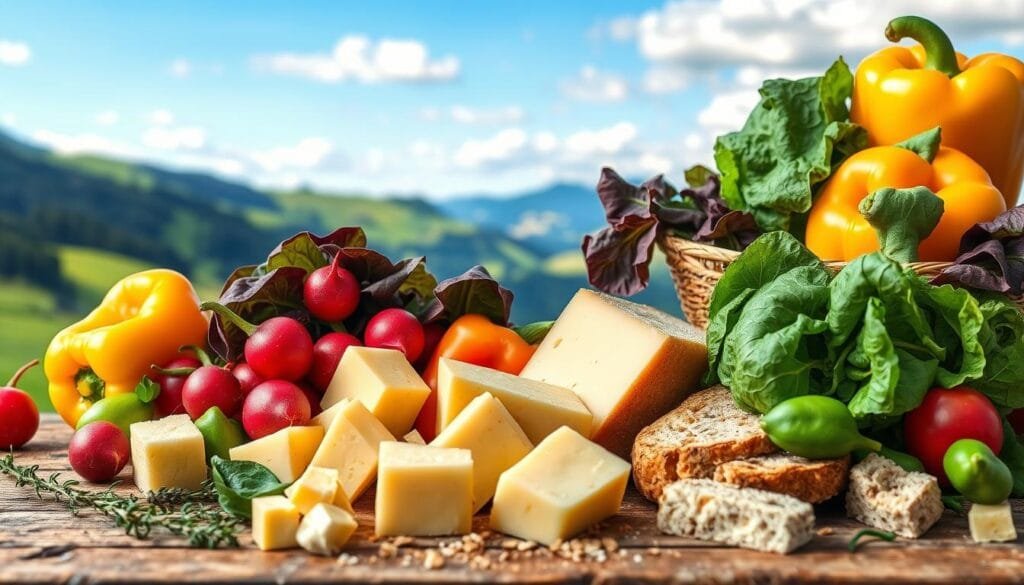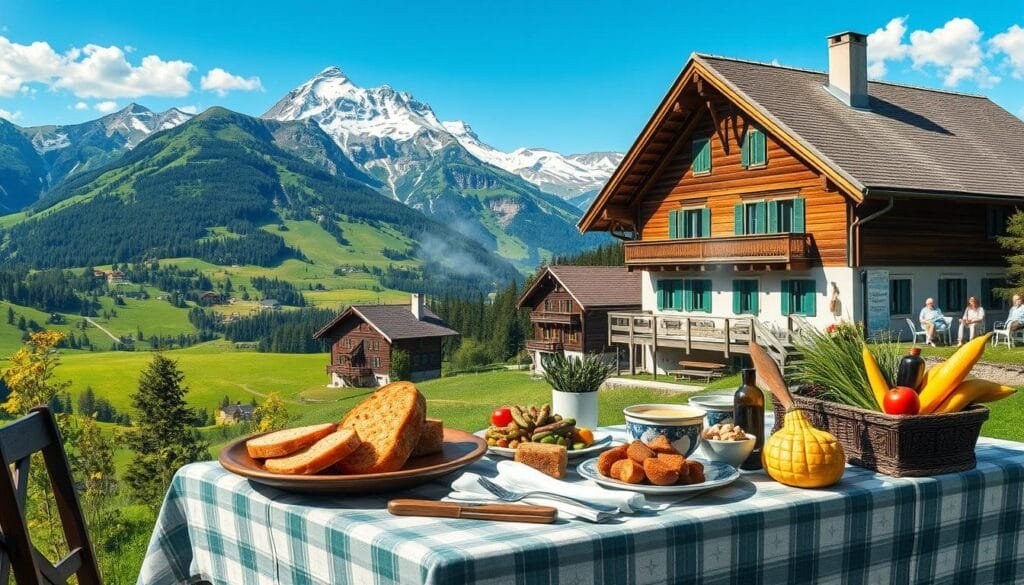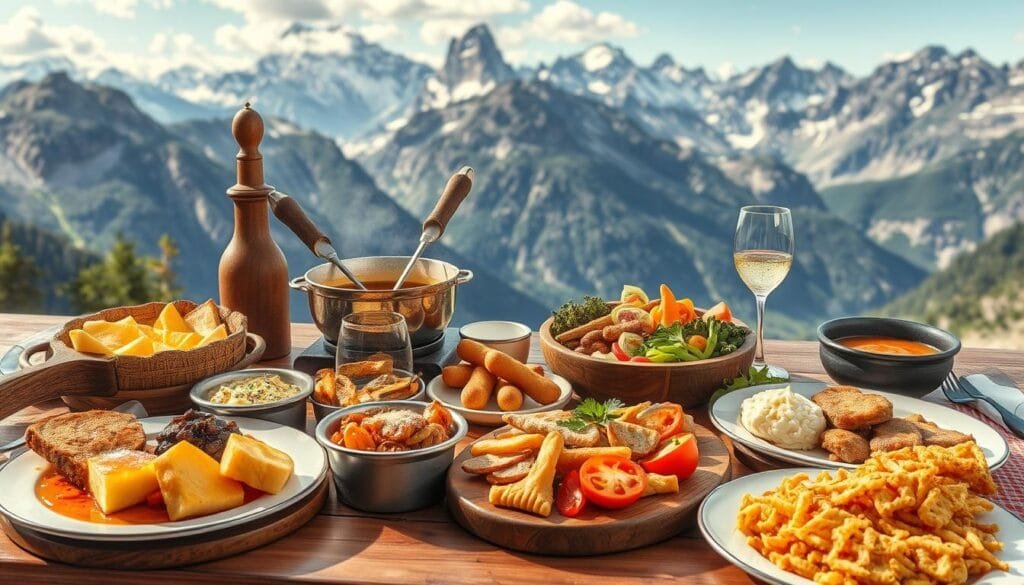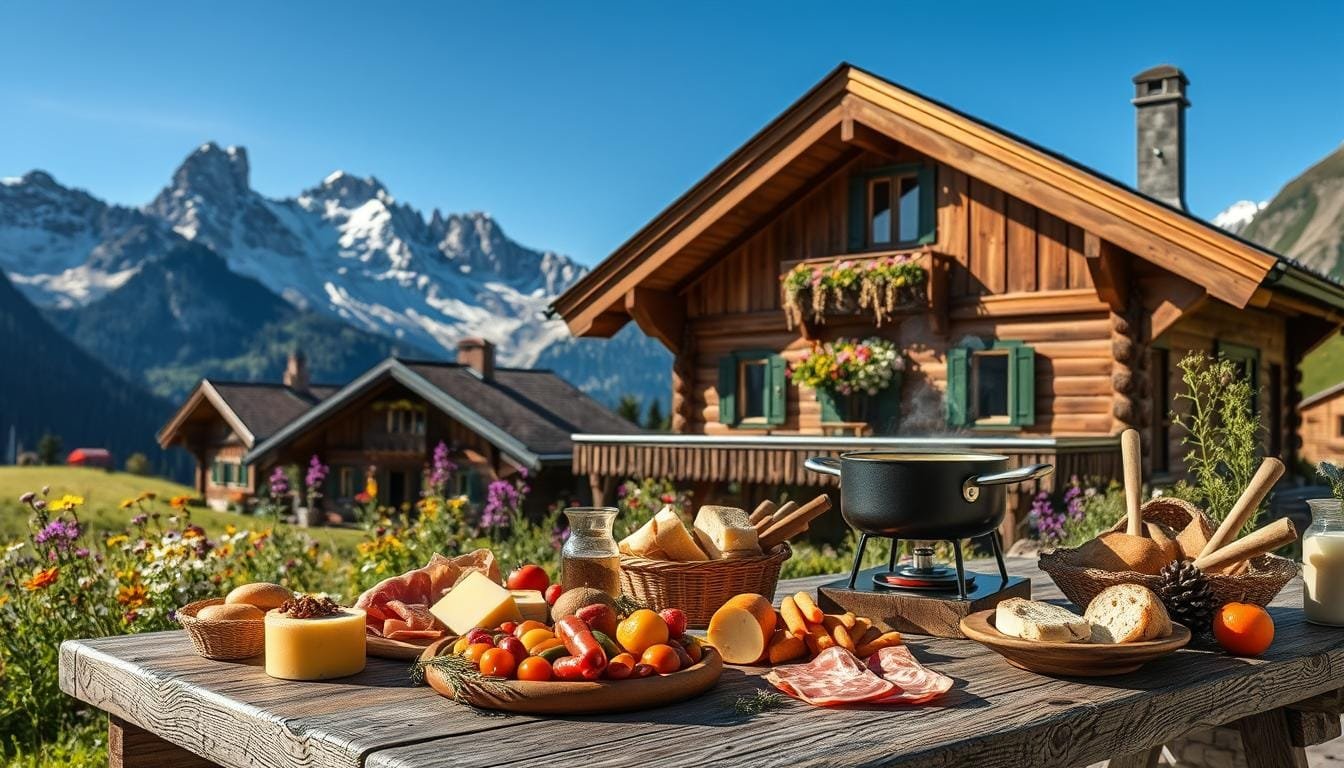Have you ever thought about how Switzerland’s Alpine climate influences its food traditions? This invites us to look into how Switzerland’s weather connects with its food. We’ll see how the climate shapes the flavors and ingredients of Swiss cuisine.
Switzerland’s varied lands impact its food culture. Its microclimates, from valleys to mountains, support different crops and animals. This diversity is key to Swiss dishes. Colder areas are great for dairy farms, giving us famous cheeses like Emmental and Gruyère. These cheeses are even protected by special labels (AOP). Other areas grow crops essential to Swiss meals, like potatoes and bread, perfect for dishes like rösti and fondue.
Key Takeaways
- The Alpine climate of Switzerland profoundly affects its local food culture, promoting unique agricultural practices.
- Cold regions are conducive to dairy farming, resulting in famous Swiss cheese varieties such as Emmental and Gruyère.
- Microclimates across Switzerland support a variety of crops, contributing to a diverse range of culinary traditions.
- Staple foods like potatoes and bread are essential to traditional Swiss dishes that provide warmth and energy.
- Cheese fondue and rösti highlight the interplay between Swiss weather and food culture.
- Approximately 70% of Swiss cheese varieties are protected by geographical indications, ensuring quality and authenticity.
The Impact of Alpine Climate on Agriculture
The Swiss Alps have a tough landscape and unique weather. This makes farming there very special. The way the land lies and the weather work together to shape farming. Among these, moving cows up and down the mountain, known as transhumance, is crucial for making Swiss cheese.
Alpine Transhumance and Dairy Farming
In Switzerland, farmers move their animals to different pastures with the seasons. In the warm months, animals feed on rich grass in the highlands. This keeps the animals healthy and makes Swiss dairy products top-notch.
Swiss dairy is famous for its quality, thanks to moving cows seasonally. This method is key to making excellent cheese and milk. These are big parts of Swiss food culture.
Seasonal Variations in Crop Production
Switzerland’s weather and altitude vary a lot, which affects when and where farmers can grow crops. In the high Alps, the growing season is short. But lower down, like on the Swiss Plateau, farmers can grow more types of crops for longer.
This pattern of farming brings a mix of food traditions across Switzerland. Farmers plant crops like barley and wheat at just the right time. This helps their farming fit perfectly with the Alpine environment.
| Region | Main Agricultural Practice | Seasonal Influence |
|---|---|---|
| Swiss Alps | Transhumance | Highland grazing in summer |
| Swiss Plateau | Cereal Production | Extended growing season |
| Lower Midlands | Mixed Farming | Moderate climate variations |
Local Ingredients Shaped by Switzerland’s Climate
Switzerland has different climate zones, from Alpine to continental. These climates influence the ingredients that grow in each area. The result is a variety of Swiss foods that showcase the country’s natural settings and cultural history.

Regions like Lake Geneva and Ticino enjoy a warmer climate. Here, grapes and fruits flourish, thanks to the mild weather. These areas are known for producing exceptional wine.
In contrast, the cold Alpine regions are perfect for growing root veggies and hearty greens. Foods like potatoes and sugar beets thrive here. They are central to many traditional Swiss meals. This diversity in agriculture shows how climate shapes Swiss farming.
Swiss farming history teaches us about climate’s effect on food production. During the world wars, Switzerland focused on local farming due to food shortages. This led to fewer food imports and a stronger reliance on local ingredients.
| Climate Zone | Main Crops | Influence on Cuisine |
|---|---|---|
| Milder Regions (e.g., Lake Geneva, Ticino) | Grapes, Apples, Various Fruits | Wine Production, Fruit-based Desserts |
| Colder Alpine Regions | Potatoes, Sugar Beets, Hearty Greens | Potato-Based Dishes, Rich Vegetable Soups |
Swiss cuisine also includes influences from Germany, France, and Italy. This mix has created a unique food scene that focuses on local ingredients. For instance, Rösti from Bern and Saffron Risotto from Ticino highlight regional produce.
The climate’s impact on Swiss agriculture affects ingredient availability and their use in dishes. Whether it’s hearty meals or light fruit tarts, Switzerland’s food reflects its ability to adapt to various climates.
How Swiss Weather Influences Cuisine
Swiss cuisine is closely tied to the country’s climate. The four distinct seasons each bring their own flavors. This creates a variety of seasonal dishes that are celebrated across Switzerland.
Dairy Products and Cheese
Dairy is key in Swiss food, thanks to the Alpine weather. Making cheese, like Emmental and Gruyère, reflects traditional preservation. This method keeps milk from going bad during the long winters. Such cheeses are central in warm dishes like fondue and raclette.
Seasonal Dishes and Preservation Methods
Swiss dishes change with the seasons. Winter brings hearty stews, while summer calls for salads and fish. Preserving food, through methods like curing and pickling, is essential. This shows the clever use of what’s local and seasonal in Swiss cooking.
| Season | Popular Dishes | Preservation Methods |
|---|---|---|
| Winter | Fondue, Raclette | Aging Cheese, Curing Meats |
| Spring | Fresh Asparagus, Wild Garlic Pesto | Pickling, Fermentation |
| Summer | Light Salads, Grilled Fish | Drying, Smoking |
| Autumn | Chestnut Dishes, Game Meats | Canning, Jam Making |
Climate-Adaptive Cooking Techniques
In places like the Alps, cooks use special methods that suit the climate. These methods, like using less moisture, help cook food faster. They also keep the food’s nutrition intact, which is great for high-altitude areas. Using local, seasonal produce links Swiss food closely with nature.
The climate hugely influences what Swiss people eat and when. They usually have five meals a day. For more on these traditions, click Expatica.
Does Switzerland Climate Affect The Culture or Food
The unique climate of Switzerland deeply impacts its culture. The variety of languages and traditions comes from climate effects. In the Swiss Alps, long winters influence how people live and move. For example, the Alpabzug is a tradition where cattle move to lower lands for the winter.

The cold climate shapes Swiss cuisine too. It’s tough to grow many crops in the mountains. So, Swiss people have mastered food preservation. Dishes like fondue and raclette come from this, perfect for the chilly weather when it’s hard to get fresh food.
Government actions also show this climate-culture link. A part of the CO2 tax funds goes to environmentally friendly projects. These efforts help agriculture adapt and lessen environmental harm. Cultural events like Fasnacht and the Böögg festival reflect seasonal changes tied to climate.
Switzerland’s different areas have various climates, influencing local foods. Around Lake Geneva, the climate is almost Mediterranean. This diversity leads to unique dishes and ingredients. Harvest and wine festivals celebrate this agricultural richness, linking food directly with climate.
To conclude, Switzerland’s climate closely connects with cultural and food traditions. This relationship highlights how environmental factors influence daily life and celebrations, enriching Swiss identity.
Regional Variations in Swiss Cuisine
Switzerland’s food scene is shaped by its many languages and cultures. From the French West to the Italian South and the German North and East, each area has its own tasty dishes. These variations give us a peek into Switzerland’s diverse culinary world.
French-speaking West
In the French-speaking West, food is inspired by French traditions. Favorites include cheese fondue, raclette, and chocolates. The cuisine here uses ingredients like Gruyère cheese to create rich, comforting meals.

Italian-speaking South
The South, where Italian is spoken, loves Mediterranean tastes. Dishes like polenta and risotto are common. They’re made with local herbs and veggies. This shows how language influences food, making this region unique compared to the rest of Switzerland.
German-speaking North and East
In the German-speaking areas, meals are heartier. You’ll find sausages and potatoes in many dishes, such as Rösti. These foods are perfect for the colder weather and show the area’s food traditions.
The difference in foods across regions shows the impact of language on what people eat. Each area’s unique dishes are more than just tasty. They tell the story of Switzerland’s rich mix of cultures.
Traditional Dishes and Weather
Switzerland’s climate deeply shapes its food traditions. The cool, high places affect what ingredients they use and how they cook. We see how the weather shapes Swiss meals through their famous dishes. These include tasty potato dishes and cheese feasts, all showing the Swiss connection to their land.
Rösti and Other Potato-Based Dishes
Rösti is a cherished Swiss traditional dish, mainly made from potatoes. It started as a farmers’ breakfast in Bern, offering warmth and comfort. The dish shows the Swiss reliance on tough, weather-beating crops. Other favorites like Kartoffelsalat and Alplermagronen also highlight the potato’s kitchen versatility through the seasons.
Fondue and Raclette
Fondue and raclette symbolize Swiss winter gatherings. Fondue blends melted cheese, wine, and garlic for shared warmth. Raclette mixes melted cheese with boiled potatoes and pickles, showing how mountain folks enjoy hearty meals. These cheese dishes also mark the Swiss way of making eating a cozy, communal act during cold times.
Seasonal Fruits and Desserts
Swiss sweets embrace the season’s fruits, adapting to the weather. Summer brings fruit tarts and compotes with fresh berries. Winter offers baked apples and chestnut vermicelli. This shows how fruit availability shapes Swiss desserts, reflecting a vibrant, weather-aware food culture.
| Dish | Main Ingredients | Best Season |
|---|---|---|
| Rösti | Potatoes | All year |
| Fondue | Cheese, Wine, Garlic | Winter |
| Raclette | Cheese, Potatoes, Pickles | Winter |
| Fruit Tart | Seasonal Fruits, Pastry | Summer |
| Chestnut Vermicelli | Chestnuts, Sugar, Cream | Winter |
Modern Adaptations and Resilience
Global warming and changing weather are challenging farmers. In Switzerland, farmers are finding new ways to adapt. They’re using smart strategies to battle climate change. These steps are key to safeguarding our food supply and nature.
Climate Change and Agricultural Practices
In Switzerland, farming is changing for the better. Farms are using drought-tolerant crops and better watering methods. About 345 million people were facing hunger by June 2022. Making farming stronger against climate change is critical.
The world’s food system is also changing. It’s becoming greener. Swiss farmers focus on precise farming and organic growth. These methods are good for the planet and help keep us fed.
Innovations in Swiss Food Industry
Swiss food businesses are becoming high-tech and green. They are using vertical farms and water gardens. These new methods are lessening the reliance on old ways. This makes farming better at surviving climate change.
New ways of keeping food fresh are being used. They focus on being eco-friendly. This matches the goals of making Swiss food sustainable.
As climate change continues, Switzerland shows us a way forward. Investing in new farm techniques and green food production is wise. It fights climate change and secures food for all of us in the future.
Conclusion
Switzerland’s unique climate and landscape shape its food culture deeply. This mix of nature and tradition shows in every dish. So, every bite tells the story of Swiss people living in harmony with their land.
Adapting to challenges like climate change, Switzerland aims for a greener future. By 2050, they plan to drastically cut greenhouse gases. This journey towards sustainability is changing how food is grown, made, and eaten. It’s all about cleaner farming and less pollution.
Mixing old food ways with new tech offers a path to keep eating well in a changing world. Holding onto culinary traditions while embracing innovation helps. This balance ensures food security and respects the earth, keeping Swiss cuisine vibrant and sustainable.
FAQ
How does Switzerland’s unique Alpine climate influence its food culture?
Switzerland’s Alpine climate favors the making of certain dairy products in colder areas. It also allows for a variety of crops due to its diverse climates. These factors have led to traditional dishes like fondue and rösti, perfect for the cold.
What is transhumance and its role in Swiss dairy farming?
Transhumance is moving livestock to different pastures with the seasons. It’s crucial for Swiss dairy, helping produce top-quality cheese and milk.
How do seasonal variations in Switzerland affect crop production?
Seasonal changes and various altitudes in Switzerland cause different crop growing times. This impacts when farmers plant and harvest. It leads to unique regional dishes for each season.
What local ingredients are common in Swiss cuisine due to the climate?
In some regions, Swiss ingredients include dairy, root veggies, and hearty greens. Fruit like grapes, which are used in wine, thrive in warmer areas. These ingredients inspire regional recipes that show off the climate and culture.
What role do dairy products and cheese play in Swiss cuisine?
Dairy and cheese are crucial in Swiss food, thanks to the Alpine climate. Well-known cheeses like Emmental and Gruyère are in classics like fondue and raclette.
How do seasonal dishes and preservation methods relate to Swiss weather?
Swiss seasons lead to food preserving methods such as curing meats and aging cheeses for the winter. Seasonal recipes feature fresh, local items available at certain times, adapting to the climate.
What are some climate-adaptive cooking techniques used in Switzerland?
Swiss climate-adaptive cooking often involves low-moisture methods, especially in the Alps. This includes making stews and slow-cooked meals that keep moisture and flavor.
How does Switzerland’s climate affect its cultural and food practices?
The Swiss climate shapes its culture and food, creating unique regional traditions and dishes. It influences how food is preserved, what dishes are made seasonally, and the overall food scene.
What are the key characteristics of regional Swiss cuisines?
French-inspired dishes, rich in cheese and chocolate, are found in the West. The South enjoys Mediterranean meals like polenta and risotto. The North and East prefer hearty foods such as meats and potatoes.
How do traditional Swiss dishes relate to the country’s climate?
Dishes like rösti and fondue come from Switzerland’s cold climate and farming history. They bring warmth and use local ingredients. Seasonal fruits add variety to desserts through the year.
How is Switzerland adapting its agricultural practices in response to climate change?
Switzerland is tackling climate change by updating farming methods and using new technology. These steps aim to keep Swiss food traditions strong despite changing climates.
